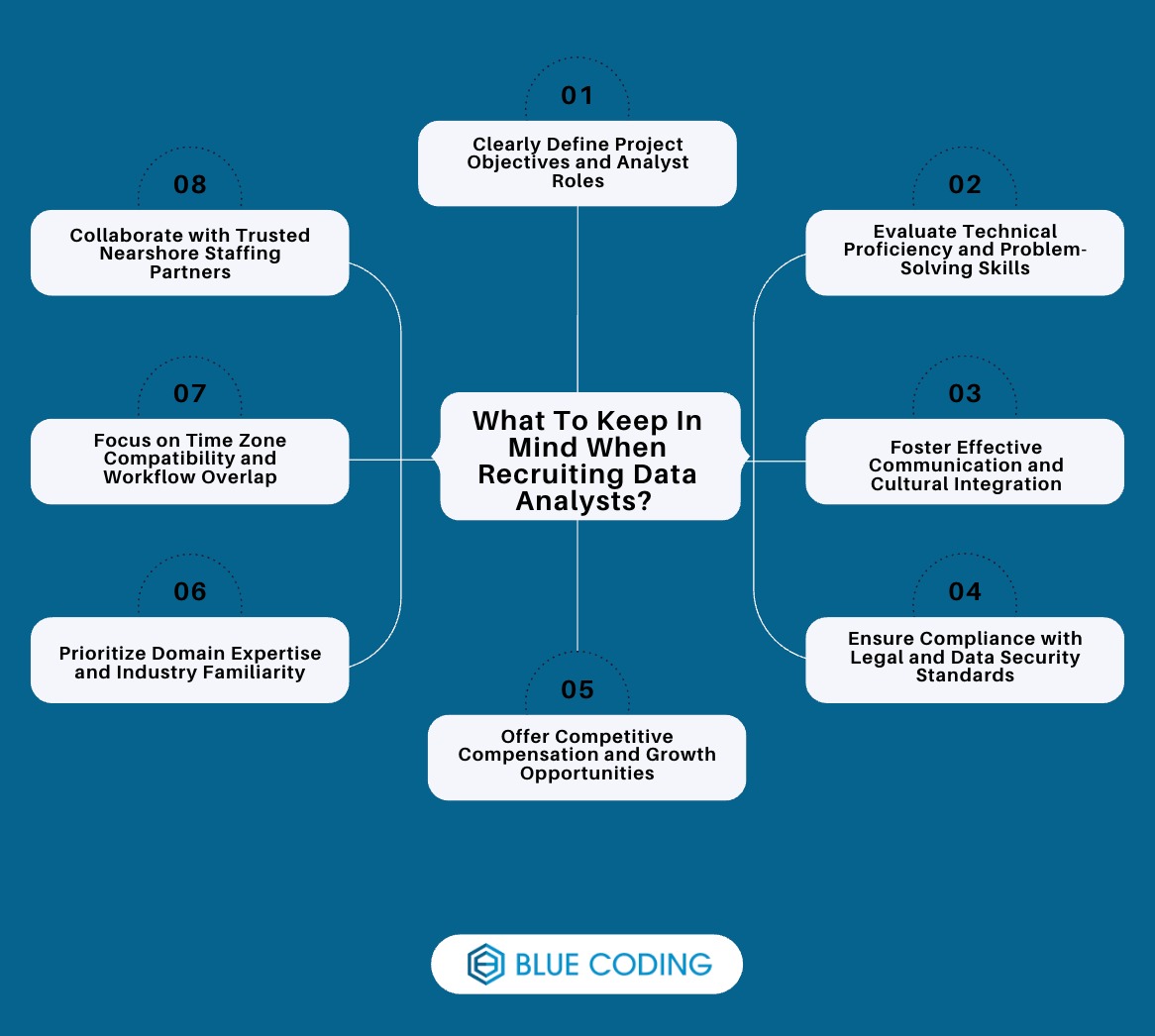 News
News
Just like all the other development practices, data analytics is also a primary part of the software development sector. A large number of startups and enterprises wish to hire the best data analytics engineers for their firm! However, it is never easy to hunt down and hire them. This is where nearshoring agencies step in! Read on to learn more about data analytics and tips on recruiting data analysts. Also, be sure to check out our post on how to use remote development to track and monitor data analytics!
Why Should You Choose to Hire Data Analysts?
Data analytics is a common term which is used often in the corporate world but are you entirely aware of why data analysts are hired? The following section explains, in detail, the purpose of hiring data analysts!
Transforming Data into Strategic Insights:
Businesses collect a vast amount of data, but it’s the interpretation that actually matters. Data analytics developers specialize in extracting patterns, trends, and meaningful insights from large datasets. Their work helps companies make strategic decisions backed by real evidence, whether it’s launching a product, expanding into a new market, or improving internal processes.
Enhancing Data Accuracy and Reliability:
Even the best tools won’t help if your data isn’t clean or consistent. Analytics developers play a crucial role in organizing and validating data from various sources. By maintaining data hygiene and ensuring consistent formats, they prevent errors that could otherwise lead to poor decisions or missed opportunities.
Improving Customer Experience:
Understanding customer behavior is key to building loyalty and improving conversion rates. With help from analytics developers, businesses can dive deep into behavioral data, segment users, and create more personalized experiences. The result is marketing that actually connects and services that evolve with user needs.
Optimizing Operational Efficiency:
Analytics developers identify inefficiencies in daily operations by analyzing process data and performance metrics. Whether it’s supply chain bottlenecks, underused resources, or redundant tasks, they help streamline operations. That not only reduces costs but also frees up time for teams to focus on higher-value activities.
Supporting Predictive Decision-Making:
It’s not just about what’s happening now, companies want to know what’s likely to happen next. Data analytics developers build models that help forecast future trends, customer behaviors, and even financial performance. These predictions give leaders a head start on strategy and a more proactive approach to planning.
Facilitating Cross-Functional Collaboration:
Different teams often work with their own sets of data, but data analytics developers bring it all together. They create unified dashboards and reports that support decision-making across departments, from marketing to finance to logistics. This ensures everyone is aligned and working with the same information.
Driving Innovation and Competitive Advantage:
By digging into user data, market trends, and product performance, analytics developers often uncover opportunities that may not be obvious. This could lead to the discovery of underserved customer segments, new product ideas, or better pricing models, giving companies an innovative edge in their industry.
Ensuring Compliance and Risk Management:
In regulated industries, non-compliance can be a costly mistake. Data analytics developers help monitor compliance metrics and identify irregularities before they become problems. Their work is essential for spotting fraud, reducing risk exposure, and keeping operations within legal boundaries.
Enabling Real-Time Analytics:
Today’s decisions often can’t wait. Analytics developers enable real-time tracking and reporting so that decision-makers can act quickly when it matters. Whether it’s adjusting a campaign mid-launch or responding to market changes, real-time insights keep the business agile and responsive.
Building a Data-Driven Culture:
Hiring analytics developers requires setting a tone. Their presence encourages a shift toward data-backed thinking across the organization. Over time, this leads to a company culture that prioritizes evidence over assumption and performance over guesswork.
What To Keep In Mind When Your Hire Data Analysts? The Best Data Analytics Recruiting Tips!

When recruiting data analysts nearshore, it's absolutely important to approach the process with strategic knowledge and cultural sensitivity. Here are key considerations to ensure a successful hiring experience:
Clearly Define Project Objectives and Analyst Roles:
Begin by articulating the specific goals of your data initiatives. Whether you're aiming to enhance customer segmentation, optimize operational efficiency, or develop predictive models, understanding the end goals will guide the recruitment process. Detail the responsibilities and expectations for the data analyst role, ensuring alignment with your project's scope and complexity. This clarity helps in attracting candidates whose skills and experiences match your needs.
Evaluate Technical Proficiency and Problem-Solving Skills:
Assess candidates' abilities through practical evaluations that mirror real-world challenges they might face in your organization. This approach provides insight into their analytical thinking, technical expertise, and adaptability. Additionally, consider their proficiency with tools and technologies relevant to your projects, such as SQL, Python, or data visualization platforms.
Foster Effective Communication and Cultural Integration:
Effective collaboration with nearshore teams hinges on clear communication and cultural understanding. Implement onboarding programs that introduce new hires to your company's values, workflows, and communication protocols. Encourage regular interactions between onshore and nearshore teams to build rapport and ensure alignment. Investing in cultural training can also bridge any gaps, promoting a cohesive work environment.
Ensure Compliance with Legal and Data Security Standards:
Navigating the legal landscape is crucial when hiring nearshore talent. Ensure that employment contracts comply with both your country's regulations and those of the nearshore location. Prioritize partners who adhere to international data protection standards to safeguard sensitive information. Regular audits and clear data handling policies can further mitigate risks.
Offer Competitive Compensation and Growth Opportunities:
Attracting top-tier data analysts requires offering competitive salaries and benefits that reflect the market standards of the nearshore region. Beyond financial incentives, provide clear pathways for career advancement, professional development programs, and opportunities to work on impactful projects. Such commitments not only attract talent but also foster long-term retention and loyalty.
Prioritize Domain Expertise and Industry Familiarity:
When hiring data analysts nearshore, domain knowledge plays a huge role. If your business operates in eCommerce, healthcare, or fintech, analysts who understand the nuances of your industry will add immediate value. They can interpret data in context, ask better questions, and contribute to smarter, more relevant insights. This domain alignment reduces onboarding time and increases impact from day one.
Focus on Time Zone Compatibility and Workflow Overlap:
Time zone alignment is one of the biggest perks of nearshoring, but it still needs planning. Choose candidates or partners in countries that allow for at least 4–6 hours of overlap with your internal teams. This enables real-time collaboration, faster iteration cycles, and quicker feedback loops. It's also worth ensuring that the analysts are used to some good communication tools so nothing gets lost when teams aren't online at the same time.
Collaborate with Trusted Nearshore Staffing Partners:
If you're not sure where to begin with hiring nearshore data analysts, working with a staffing partner that specializes in LATAM or other nearshore regions can make all the difference. These partners know the talent landscape, local labor laws, and what candidates expect. More importantly, they’ve already vetted top talent, so you don’t need to start from scratch. This makes hiring faster, safer, and more efficient, especially if you’re scaling a team or starting from zero.
Multiple Ways To Hire Data Analytics Developers, Which One’s Right for You?
When hiring data analytics developers, there’s no one-size-fits-all approach. Different business goals require different hiring models, and knowing your options helps you move faster and smarter. Let’s break down the most common ones:
Freelancers:
Freelancers are great for short-term projects or one-off tasks like building dashboards, cleaning datasets, or running exploratory data analysis. They’re flexible, usually budget-friendly, and you can find a lot of talent on platforms like Upwork or PeoplePerHour. But they often juggle multiple clients, which means you may not get consistent attention, and long-term reliability can be tricky.
Onshore Developers:
Hiring developers in your own country means easier communication, cultural alignment, and similar work schedules. Onshore teams are often preferred when security, regulatory compliance, or high-stakes collaboration is involved. That said, costs can be significantly higher, and local talent pools can be surprisingly limited, especially for advanced data analytics roles.
Offshore Developers:
Offshoring, typically to regions like India or Southeast Asia, helps reduce costs drastically. You can tap into large pools of technically skilled professionals at lower rates. The challenge, though, is time zones. A 10–12 hour difference can slow things down, especially for teams that need real-time collaboration or daily stand-ups.
Nearshore Developers:
Nearshore is where a lot of companies are putting their bets, and for good reason. Hiring data analytics developers in nearby countries (like LATAM for US-based businesses) gives you the best of both worlds: cost savings, cultural affinity, and overlapping work hours. Analysts are usually fluent in English, work similar business hours, and understand the North American business mindset. That makes communication seamless and output more aligned with your goals. Plus, many LATAM countries have strong STEM education systems and are producing seriously competitive talent. So, while each model has its place, nearshore often hits the sweet spot, especially if you're building a data team that’s agile, integrated, and long-term focused.
Ready to Hire Data Analytics Developers Through Nearshoring?
At Blue Coding, we find you data analytics developers and connect you with professionals who understand your business, your challenges, and your goals. Our nearshore staffing model means you get top-tier talent from LATAM, fully vetted, fluent in English, and aligned with your time zone. Ready to work with analysts who transform analytics into real business insights? Contact us and let's discuss your business requirements on a free strategy call!



